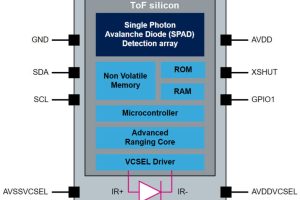Infineon has announced a 5V version of its compact (13.8 x 14 x 7.5mm) CO2 sensor.
“The sensor is based on the photoacoustic spectroscopy principle, where CO2
molecules within the sensor cavity absorb infrared light, generating small pressure changes that are detected by an acoustic detector,” according to the company. “CO2 concentration is then delivered in the form of a direct ppm readout, thanks to the integrated microcontroller.”
PASCO2V15 operates from two rails: 3.3V (10mA average) for the digital section and 5V for the internal infra-red emitter – the latter typically drawing peaks of 265mA (290mA max), which averages to 1mA at one reading a minute.
The earlier PASCO2V01 needed the 3.3V (6.1mA av) digital rail, plus a 12V (130mA typ, 150mA max, 0.8mA av) supply for the IR source.
Both devices consume ~30mW in normal operation.
 Accuracy has suffered with in the new part, which is specified at ±50ppm ±5% of reading between 400 and 3,000ppm, compared with ± (30ppm +3%) of reading between 400 and 5,000ppm for the original PASCO2V01 – both at 25°C, 1,013hPa, rH=30% ambient. Both can handle concentrations across 0 to 32,000ppm.
Accuracy has suffered with in the new part, which is specified at ±50ppm ±5% of reading between 400 and 3,000ppm, compared with ± (30ppm +3%) of reading between 400 and 5,000ppm for the original PASCO2V01 – both at 25°C, 1,013hPa, rH=30% ambient. Both can handle concentrations across 0 to 32,000ppm.
On the flip side, response time has improved to 55s, down from 90s in the 12V sensor.
All three interfaces are retained: I2C, UART and PWM.
“The sensor’s design is dust-proof in accordance with ISO 20653:2013-02,” said Infineon, and it “meets the performance criteria of the Well Green Building Standard”.
 As the sensor is pressure-dependent, the internal microcontroller can apply pressure compensation to its reading, but only if pressure information gathered elsewhere is supplied by an external processor.
As the sensor is pressure-dependent, the internal microcontroller can apply pressure compensation to its reading, but only if pressure information gathered elsewhere is supplied by an external processor.
Sensor accuracy drift aging can automatically be corrected for each week, although “the device must be in contact with the reference concentration for at least 30 minutes – for example, fresh air at 400ppm CO2“.
Any reference concentration between 350 and 1,500ppm can be used, and the correction can also be commanded if a reference atmosphere is immediately available.
Applications are foreseen in air conditioning systems and room controllers – in both commercial and residential buildings – as well as in smart horticulture and smart refrigerators.
 Electronics Weekly Electronics Design & Components Tech News
Electronics Weekly Electronics Design & Components Tech News




